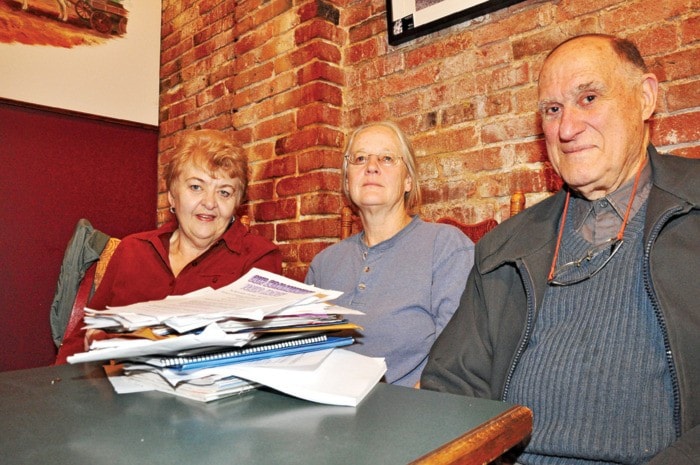By Christopher Sun
The Chronicle
Smoke signals emanating from North Oyster show plans for a pair of new fire halls could crash and burn the way a proposal for a single hall did in 2007.
A referendum on Nov. 19 will ask area residents if they are in favour of borrowing up to $3,030,000 to build a three-bay replacement fire hall in North Oyster and a new two-bay hall at Coffin Point.
While community consensus supports the need to replace the old hall, opponents are saying the referendum should go up in flames, citing the $3 million price tag, the parcel tax being used to pay for it, and frustration with the process.
The project will be financed by an annual parcel tax of $248.96 on each of the 1,059 parcels in the North Oyster protective services area over 20 years. Critics Jerrilyn Harris, Rita Dawson and George Shephard said it should be done differently.
“It should be by assessment,” Shephard said. “Big money would be saved that way. I heard that if Terasen Gas paid by assessment, they would pay more. $38,000 a year versus $248.”
The three dispute North Oyster Director Mary Marcotte’s claims that tax by parcel is what the majority of citizens want.
“It’s what she’s always wanted,” Harris said, pointing out the page out of the hundreds she has received from a Freedom of Information request.
“If you look at the ad-hoc committee’s final recommendation (dated June 30, 2009), the committee recommended that the tax should be based on assessment.”
Marcotte said she has always being a strong supporter of a parcel tax because it is what the majority of the community want. She explained a number of communities are using the parcel tax method to fund new fire halls because it’s fairer.
“Quite a few people are paying the minimum amount of taxes in total, when you factor in the homeowners grant, which is $350 a year,” Marcotte explained. “There are a lot of people paying $1,000 to $10,000 a year in North Oyster, for the same service of those who pay $350.
“People will still pay the highest on assessment since the cost of operations is based on assessment.”
Marcotte added that replacing the current fire hall has been in the area’s master plan since 1984. She feels having these two new fire halls will help attract new volunteer firefighters, which is needed as the population ages and more people move into the area.
Harris said a comprehensive, independent review on the community’s needs should be done, detailing what the cost of running a new fire hall or two would be.
The critics also raised issue with the amount of public consultation and say they keep running into roadblocks when trying to access public documents budget, expenses, and detailed annual reports.
Greg Wyndlow, a former area director, sat on the ad-hoc committee. He said the whole process was flawed.
“There is a whole bunch of things wrong,” Wyndlow said. “They don’t even own the land to expand the (existing) fire hall on.
“It’s simply not ready to go ahead.”
An ad-hoc citizens committee was set up in 2009 to review the proposed fire hall replacement after a 2007 proposal to build one fire hall was defeated by the public.
The six-person committee was chaired by Howie Davis, who was appointed by Marcotte. Davis in turned named five people to the committee, including the since-departed William (Bil) Derby.
Critics are concerned Derby is a director with Tectonica, a firm involved with both the failed 2007 fire hall bid and the current one. Derby’s wife Kara, meanwhile, was the secretary of the committee and works for Davis.
“This is a conflict of interest in my opinion,” Dawson said. “No one in North Oyster is against building a new fire hall, it is needed. But we are against the cost and the process.”
Derby said his company had a contract to manage the original fire hall project, but that ended once the alternative approval process was defeated in 2007. He was then asked by Davis to join the volunteer ad-hoc committee due to his prior experience and the fact that he lives in the area.
“When the project became viable again, I was contacted by the CVRD,” Derby explained.
“I then stepped down from the committee and became a consultant.”
Managing the project will involve hiring the architecture firms, contractors and builders, all of which would go to tender, he added.
CVRD spokesperson Mark Kueber said the district has paid Tectonica about $48,000 to manage the project since August of 2009.
North Oyster’s director stands behind the process.
“I disagree that there could be a conflict in any shape or form because (Derby) was not tied to the CVRD,” Marcotte said. “Bil had the information and they (the committee) needed a lot of his experience to move on.”
Davis was actually one of the volunteers who helped build North Oyster’s existing fire hall 50 years ago. He owns 10 parcels, which means he will be paying almost $2,500 a year.
“I don’t like the cost,” Davis said. “And who’s going to get burnt the most out of this? It will be me and I support it.”
Davis said the cost to build the fire halls will keep on increasing if there is anymore delay.
He noted that the $3 million price tag is just a worst case scenario and he believes the district will work to come under budget.
“The fire department is a very integral part of the area,” Davis said. “We need to have a good fire hall with rooms and showers to attract new firefighters, and we don’t have enough of them right now.”
